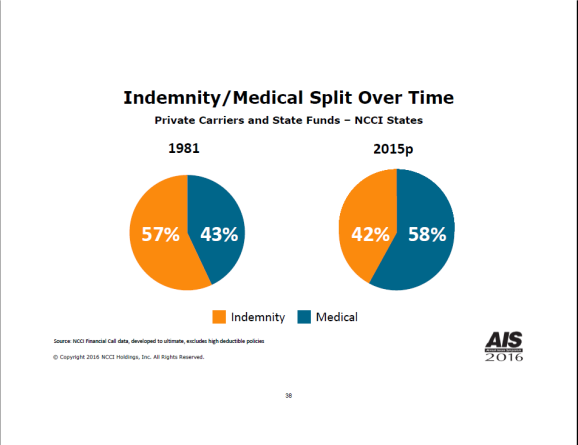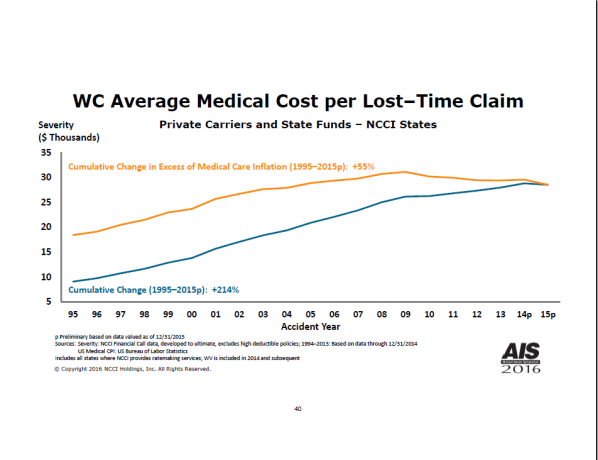Once again it is time to look at the average medical costs for lost-time claims in workers’ comp. as reported last week in the NCCI State of the Line Report at the 2016 Annual Issues Symposium.
Those of you who have read my White Paper, or have followed this blog for sometime, know that this is an annual meeting of industry people in Florida to look at what is happening in workers’ comp.
It is not a conspiracy meeting of insiders looking to harm injured workers, as one deranged individual has suggested. [Emphasis added]
But rather, it is one way in which insurance personnel can understand where the workers’ compensation insurance market is headed. And the word this year, from Joe Paduda’s reporting last week is “Transitioning”.
Workers’ comp is transitioning and what it is transitioning into has been discussed previously by both Joe and Peter Rousmaniere, and that I have described in earlier posts.
One aspect of this transitioning has to do with automation and the development of artificial intelligence that will make many current jobs obsolete [remember that Twilight Zone episode with Burgess Meredith and Fritz Weaver where the State declared them both ‘obsolote’?]
Another part of this transitioning relates to the so-called ‘gig economy’ of companies like Uber and Lyft, Airbnb, etc., as well as the move of some jobs to part-time from full-time status, whatever the reason given.
But let’s move on to the issue at hand, which is, what is the average medical cost for lost-time claims this year. As you will see in the first chart, the average medical cost for lost-time claim dropped 1% from 2014, where there had been an increase from 2013 of 3%.
Chart 1.

Unlike past charts, this year’s chart shows that there are two years of preliminary data, 2014 and 2014. Compare that to last year’s chart, found here, as well as the two previous years, 2014 and 2015.
In 2014, the average medical cost per lost-time claim was $28,800; in 2015, the average medical cost dropped a mere $300 to $28,500, not very significant, but perhaps signalling a leveling off. You will notice in my previous articles and in my White Paper that I included a trendline that always showed the cost increasing, but it is apparent by looking at this year’s chart that there seems to be a flattening occurring.
According to Kathy Antonello’s report, the two key takeaways are:
- Medical severity change has moderated in recent years
- The 2015 average medical cost is 1% lower than the 2014 value
Another factor to consider is how much of the total claim cost does medical payments per claim represent. As shown in the second chart, medical costs have remained at 58% of total claim cost, with indemnity (lost wages) representing the rest.
Chart 2.

As you can see, medical costs have risen significantly since 1981. Another way to view the change in average medical cost and its apparent leveling off can be seen in the third chart.
Chart 3.

Chart 3 indicates that the cumulative change in excess of medical care inflation from 1995 to 2015 has joined the cumulative change in average medical cost from 1995 to 2015p in leveling off.
What this means, according to Ms. Antonello, is that workers’ comp medical costs per claim have risen at a much faster pace than indemnity over the past thirty years, medical inflation has outpaced wage growth, medical lost-time severity has increased 214% since 1995, and the corresponding increase in medical lost-time severity over and above the increase in medical price inflation is 55%.
What this also indicates is that workers’ comp is changing, and many predict that in a few years, workers’ comp as we have known it will disappear. Then perhaps treating injuries to certain body parts as knees, backs, shoulders, etc., common to both workers’ comp and general health care won’t be separated into different silos, but rather paid for as one medical expense under an employer’s health plan or even a single payer plan.
Either way, medical travel, given the predicted shortages of physicians and nurses, may present itself as a viable alternative, and not be subjected to antiquated laws and statutes that restrict an injured worker from getting medical care wherever they want to. And if predictions about artificial intelligence and automation are correct, then it won’t really matter, since very few individuals will be hurt on the job in the future.
There is an old Chinese curse: “May you live in interesting times.”
I am willing to work with any broker, carrier, or employer interested in saving money on expensive surgeries, and to provide the best care for their injured workers or their client’s employees.
Ask me any questions you may have on how to save money on expensive surgeries under workers’ comp.
I am also looking for a partner who shares my vision of global health care for injured workers.
I am also willing to work with any health care provider, medical tourism facilitator or facility to help you take advantage of a market segment treating workers injured on the job. Workers’ compensation is going through dramatic changes, and may one day be folded into general health care. Injured workers needing surgery for compensable injuries will need to seek alternatives that provide quality medical care at lower cost to their employers. Caribbean and Latin America region preferred.
Call me for more information, next steps, or connection strategies at (561) 738-0458 or (561) 603-1685, cell. Email me at: richard_krasner@hotmail.com.
Will accept invitations to speak or attend conferences.
Connect with me on LinkedIn, check out my website, FutureComp Consulting, and follow my blog at: richardkrasner.wordpress.com.
Transforming Workers’ Blog is now viewed all over the world in 250 countries and political entities. I have published nearly 300 articles, many of them re-published in newsletters and other blogs.
Share this article, or leave a comment below.
Are all those numbers normed to today’s dollars? My groceries, clothes, gas, vet bills, and lawn care all cost more now than 20 years ago, too. If not in today’s dollars,misleading graphics.
LikeLike
I would assume so, since they are based on the most recent figures NCCI has.
LikeLike
Ms. Antonello did not speculate why medical costs (ave cost per LTC) have declined…a lot of these costs are projected rather than paid…my guess is it that has something to do with moderation in drug utilization.
LikeLike
That is true, Peter, that is why this is the first time I have seen two years of preliminary data…I have the reports going back to 2009 (2010 presentation). But also, they never quite spell out what is in the medical cost figures. Is it just drugs and treatment costs, or does it include surgery and hospital bills?
LikeLike